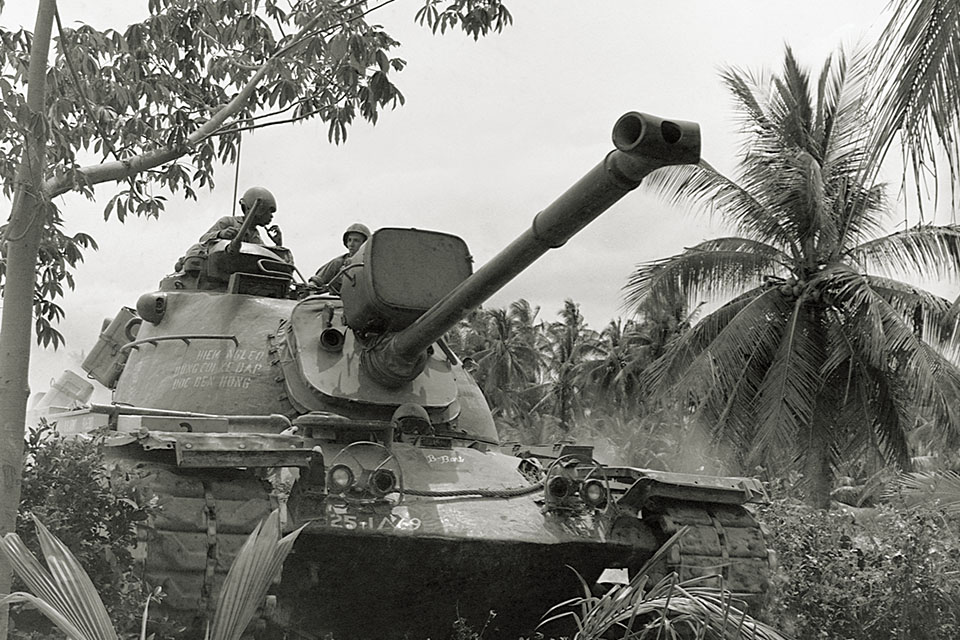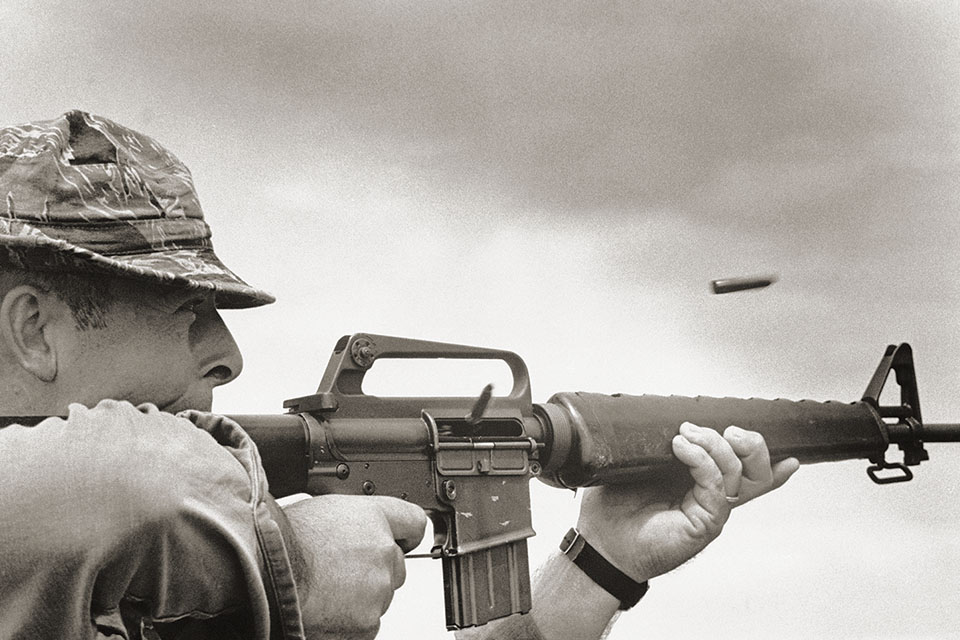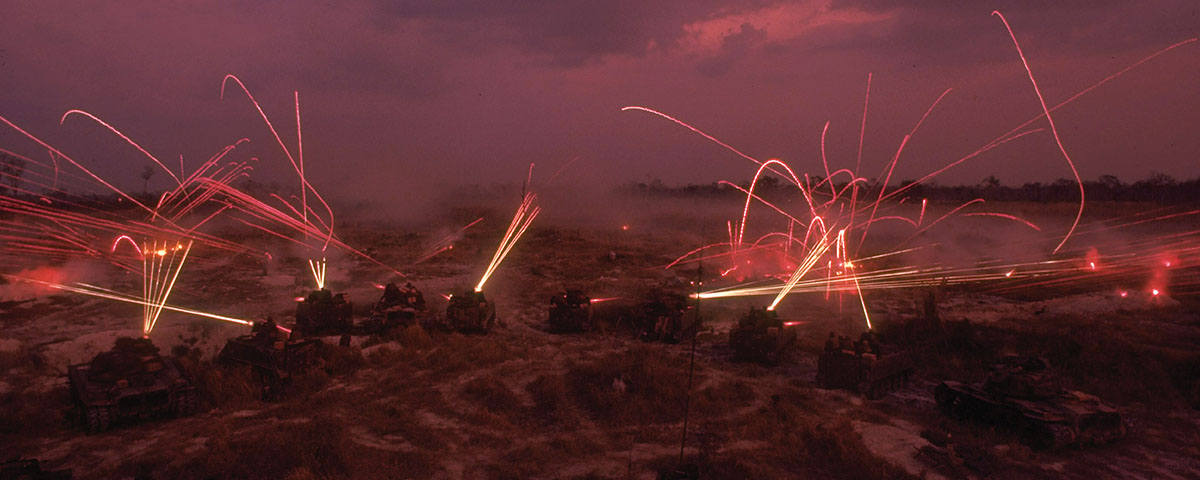Many articles and books about the Vietnam War, and other wars, understandably emphasize the feats of frontline fighting troops. While that focus on combat action provides interesting reading, it unfortunately overlooks the stories of the vast corporate enterprise working in rear areas to make that exciting battle mayhem possible. These mostly unsung logisticians, often derogatively referred to as “loggie toads,” are generally invisible—except, of course, when they screw up.
One of the best known historical examples of a screw-up—quite literally, involving screws!—is the January 1879 Battle of Isandlwana during the Anglo-Zulu War in South Africa, where two battalions of British regulars, augmented by several hundred locally recruited native contingent troops, took on 20,000 Zulu warriors. The Redcoats, firing as fast as possible to hold back the onrushing Zulus, soon ran low on ammunition. They dispatched runners to the rear for resupply, but Quartermaster Edward Bloomfield demanded that the runners queue up and wait their turn for more ammunition. Soon officers arrived from the front and seized the coveted ammunition boxes from Bloomfield, only to find that the lids were held on by screws—and they didn’t have any screwdrivers. The desperate Redcoats used their rifle butts to break open the boxes, and bent screws are still being found by treasure hunters. In the end, however, the retrieved ammo wasn’t enough. Thousands of Zulus armed mainly with assegais, a hybrid of a spear and stabbing sword, overwhelmed the seriously outnumbered British riflemen and won the battle.
Fortunately, Americans troops needing ammo have never been at the mercy of a punctilious British quartermaster. Since the War of 1812 the U.S. Army has understood that quartermasters, with their focus on how many raisins each soldier is allocated in his breakfast muffin each day, are not suitable for ammunition duties and replaced them with folks who like loud noises—well-trained ordnance professionals.
A fundamental principal of U.S. Army operations is superior firepower. That means putting more rounds on the enemy than he is putting on you. In practical terms, that means a lot more rounds. In Vietnam, 1st Infantry Division commander Maj. Gen. William DePuy insisted that three batteries of artillery were much better for pounding an enemy position than just one.
The Army is a bureaucratic organization and therefore thrives on order and discipline, but shoveling tons of ordnance on the enemy in the heat of a battle is by its nature a chaotic endeavor, contrary to the order that the military culture loves. This obsession with order and the focus on procedure over result—I call it the “Bloomfield Effect”—must be overcome so that ammunition flows fast to troops seeking overwhelming firepower to demolish the enemy.

Were there any Bloomfield Effects during the Vietnam War? An obvious first look would be the response to the communists’ Tet Offensive in late January 1968, as American and South Vietnamese forces faced a 20th century Isandlwana when they were attacked by the North Vietnamese Army and Viet Cong. During the Lunar New Year holiday, tens of thousands of Viet Cong and NVA troops suddenly emerged from hiding places in jungles, towns and holes throughout South Vietnam, creating countrywide chaos. Of course, 80,000 communist troops versus some half-million U.S. troops and an even greater number of South Vietnamese soldiers might not seem like such bad odds, but the enemy was well-armed and had the element of surprise. While the scope of the onslaught was certainly shocking and the ammunition supply system was taxed to its limit, there was never a significant failure, and thus the comparison to Isandlwana soon loses traction. Ammunition operations did the job and, as usual when work is well-performed, remained invisible.
Things had calmed down by the summer of 1968, when I arrived at the 1st Logistical Command headquarters at Long Binh, about 20 miles northeast of Saigon. I was a first lieutenant with the title, “ammunition stock control officer (conventional),” assigned to the 182nd Stock Control Detachment.
The 1st Logistical Command—whose operations in Vietnam included truck units, supply depots, equipment repairs, port development, food and clothing distribution and more—was staffed with about 50,000 troops. It had ordnance (ammunition) battalions throughout South Vietnam except for the Mekong Delta, where a single ammunition company worked with naval operations there. The 182nd Stock Control Detachment had about 20 folks on the day crew and 10 at night.
Intense combat in the months before I arrived had left some obvious scorch marks on various folks in 1st Log, but the war had since shifted back to the “boonies,” and our close-up views of ammunition operations “at the front” were less frequent. My night crew’s life was one of monotony: recording ammunition transactions on tally sheets, transferring the data to key punch cards and creating color-coded display charts for the brass to examine each morning. My personal duties included regular midnight phone calls to the Army Materiel Command’s ammunition center in Joliet, Illinois. I had to call at that hour because of the time differences. An occasional VC rocket or mortar round sent our way provided some excitement, as did a major attack on the base in February 1969.
The “well-oiled machine” cliché applied to our ammunition operations. However, every once in a while, quartermaster Bloomfield’s ghost would waft in, and peculiar situations would ooze their way into my office from the maelstrom in the field.
That is what happened after the NVA tank attack on Ben Het on March 3, 1969. The sudden appearance of a North Vietnamese armored force was a shock to everyone, even though it was far away in the Central Highlands and the NVA unit was composed of anemic PT-76 amphibious tanks (armed with 76 mm main guns) and equally thin-skinned BTR-50 personnel carriers with machine guns.
The Ben Het firebase sat only a few miles from the Laotian border, where the base’s long-range M107 175 mm guns could fire directly on the nearby Ho Chi Minh Trail, the NVA’s lifeline. The base was situated on three hills. There were three companies of friendly Montagnard tribal militias on Hill One; a long-range 175 mm battery from the 6th Battalion, 14th Artillery Regiment, on Hill Two; and three dug-in M48 tanks from 1st Platoon, Company B, 1st Battalion, 69th Armor Regiment, on Hill Three—all under the command of the 4th Infantry Division. The tanks had the essential mission of defending Ben Het’s airstrip and blocking Highway 512, the primary road to the main base at Dak To.
After several days of mortar and rocket attacks that began in late February, the Ben Het base’s defenders began hearing ominous sounds of tracked vehicles on March 2. Despite the use of night vision equipment and spotlights, they were unable to precisely locate the enemy. But on March 3, a tank from the 4th Battalion, 202nd Armored Regiment, 65th NVA Division, set off anti-personnel mines while advancing on Hill Three. A vicious tank battle ensued, the first for U.S. troops since the Korean War.
For a while both sides were forced to shoot blind at muzzle flashes, with little or no effect. Then some 15 NVA tanks began maneuvering around the 69th Armor’s left flank, toward the airstrip. There the American M48s started scoring hits, destroying two North Vietnamese PT-76s and a BTR-50. The NVA tankers countered with a direct hit on an M48, killing the machine gun loader and gunner. They then withdrew.
The American tanks were firing very lethal “high-explosive anti-tank,” or HEAT, rounds as well as conventional high-explosive ammunition, according to then-Capt. Gerald R. Cossey, chief of supply of the 4th Infantry Division. But one wonders why the M48, which had never encountered an NVA tank before, was packing anti-tank rounds. I thought the M48s would have few, if any, anti-tank rounds in their racks because they primarily attacked enemy infantry. In those fights, anti-tank rounds were not as effective as regular high-explosive rounds.
HEAT rounds are designed to pierce armor, while normal high-explosive rounds detonate outside of an enemy tank’s skin. The nose of a HEAT round is hollow, with the explosive charge shaped around a cone in the rear. When the round strikes a target, electric crystals send a charge to the rear, initiating the detonator. As the blast progresses forward, the cone causes the blast to crisscross on itself, forming an extremely strong explosion intensely concentrated in the center, little more than an inch wide. This superblast will penetrate most armor. While penetration is small, the blast effect on soldiers inside the tank is catastrophic.
The NVA’s hit on the dug-in American tank is also peculiar. The round struck the M48 squarely on its strongest point, the sloped front metal plate. The tank itself was virtually undamaged, suffering only a bent operating handle on the top-mounted .50-caliber machine gun—the gun that the tank’s loader and gunner were operating. They would have been safe inside the tank. So why were they outside with the machine gun? Either the crew had run out of ammunition for the main gun or the men decided to blanket the enemy with .50-cal bullets, which can be effective against the thin-skinned PT-76. The two other crewmen who were outside, the tank commander and company commander, were blown off the tank, but not killed. Not only did employment of the machine gun expose the gunner and loader, but the .50-cal’s notable muzzle flash can be a target for the enemy to zero in on.
With the sudden appearance of an enemy tank force, demand for HEAT ammunition suddenly mushroomed. During the confused tank ammo resupply operations later that day, the Bloomfield Effect was rampant.
My involvement came the following night. One my clerks answered the phone around 11 p.m., turned to me and said in an ominous tone, “Lieutenant, you’d better take this.” On the other end of the line was a major, the head of 4th Infantry Division’s supply and logistics staff.
“I have a problem,” the major began. The division’s tankers were in desperate need of anti-tank ammunition, and he didn’t know where to get any. The 69th Armor had none, making me wonder if they had any to begin with. Nor was there any at the 4th Division’s base at Dak To or the division’s own ammunition supply point at Pleiku.
The major, sending a requisition up the supply chain, didn’t have any luck at the ammunition depot in Qui Nhon on the coast or the next depot farther south at Cam Ranh Bay. The requisition eventually landed at the 3rd Ordnance Battalion’s Long Binh ammunition depot, right down the street from where I worked. It turned out this was the only place in Vietnam that had the suddenly coveted HEAT rounds. But the major, after recapping all of the places he had contacted that day, said the 3rd Ord night crew insisted that the requisition was nowhere to be found. The major asked me if I could help. I expostulated one of my most memorable quotes of the war: “Well, we normally don’t get involved with direct issues of ammunition here, sir.”
With great enthusiasm the major instructed me on the need to expand my job description. We both agreed that I would find his HEAT ammunition and report back to him—in an hour.
Calling the 3rd Ord nighttime ammo counters, I found they were still reluctant to wade through that day’s transactions to find the missing anti-tank rounds. However, with a bit of bluster and a bit of bluff I convinced them they should. About 20 minutes later they called back with the status: The rounds had gone out of the depot and were currently sitting in the cargo hold of a C-130 transport plane. I asked for and got the aircraft’s tail number. A call to Bien Hoa air base located the pilot, who in true flyboy fashion assured me the flight would depart for Pleiku “at first light, providing the weather is decent.”
The major called at precisely the one-hour mark, and I updated him. He said “fine” and hung up. The next morning, I was called into the office. I had to convince my majors and colonels that I had not called a combat emergency and explain why 3rd Ord thought I was such a nasty SOB.
But one is left to wonder just how much anti-tank ammunition the 69th Armor had for this battle. Cossey indicated the 69th fired both HEAT rounds and regular high-explosive rounds at the enemy tanks. Since the tank crews’ mission up to that point had been providing indirect fire at suspected enemy infantry positions in the jungle, it seems unlikely they would allocate much valuable space in their tanks’ ammunition racks for rounds they likely would never fire.
For the record, about five months later a force of Hmong mercenaries, supporting U.S. troops, descended from the Plain of Jars in Laos and seized 25 North Vietnamese PT-76 tanks. Thus NVA armor would not raise its ugly head again until near the end of the war—after our all armor guys had gone home.
The subject of Laos recalls another ammunition conundrum that arose a short time later. A late call, again followed by “Lieutenant, you’d better take this,” put me on the phone with the 1st Log’s three-star commander, Lt. Gen. Joe Heiser. His first question was, “Who is this?”
I answered, “Lt. Van Eldik.”
“No, I mean what’s your first name?”
“Jim,” I replied.
“Jim, I have a problem I want you to help me solve.”
The general went on to explain that a problem had arose in the CIA’s “secret” war against the communists in Laos. The war planners at CIA headquarters in Langley, Virginia, had arranged for 10,000 M16 rifles to be shipped to one of our allies, the Laotian Royal Guard. However, the CIA soon realized that the bullets being used in the Guard’s M1s, Sten guns, Thompson submachine guns, 1903 Springfield rifles and similarly old Lee-Enfield rifles would not fit in an M16. Therefore, they needed an immediate delivery of 2 million rounds of 5.56 mm M16 ammo.
The general’s question was: “Where should I get it?” The answer was easy. Our depot at Cam Ranh Bay had a relatively low issue rate of M16 ammo and was greatly overstocked. The general took my advice and issued his fait accompli decision the next morning to my commanders. Millions of M16 rounds were soon loaded on C-130s winging their way west.
This time the meeting with my superiors was somewhat different, more resembling an intense group self-analysis at a resort in Big Sur, California. Incidentally, the 2 million-round issue is not as impressive as it might sound because the 1st Logistical Command issued more than 2½ million rounds of M16 ammo every day.

A final Bloomfield situation I witnessed, if I remember correctly, was in April 1969. Again, another call came in close to midnight, this time from a Navy lieutenant somewhere in the Mekong Delta. How he found a telephone—or my number—I have no idea. Despite sounding like someone from a college fraternity, the lieutenant was a swift boat commander, one of the Navy’s real killers, and had expended all of his ammunition. He was now many miles away from his support base at Cat Lo and wanted to know if the Army could provide him with some ammunition. We determined that he was less than 20 miles from a major ammunition supply point at Dong Tam, right on the Mekong River network.
“Will the Army give me the ammunition I need?”
he asked.
“Of course.”
“What will I have to do to get it?”
“Write down everything you want on a DA-581 form and sign it.”
“That’s it?”
“Yup.”
“How will they know I am who I say I am?”
After briefly discussing the obvious physical differences between a U.S. Navy lieutenant and a typical Viet Cong, I suggested he show the soldiers his green military ID.
In 1977, apparently to avoid such situations in the future, the Pentagon put all conventional ammunition under the administrative control of the Army. While the Bloomfield Effect is something those in the ammunition supply business should keep in mind, the words of Rudyard Kipling are the ones that an army and its ordnance crews should live by:
A man can never have too much
red wine,
Or too many books,
Or too much ammunition.
Jim Van Eldik is a retired Army lieutenant colonel. He was discharged from active duty following his Vietnam tour and shortly afterward was assigned to an Army Reserve unit. He went back on active duty in 1983 and retired in 1995.
This article was published in the April 2019 issue of Vietnam.





